Avoid Clogs and Damage: Never Flush Cat Poop Down Your Toilet - Professional Insights
Avoid Clogs and Damage: Never Flush Cat Poop Down Your Toilet - Professional Insights
Blog Article
Just how do you feel when it comes to Can You Flush Cat Poo or Litter Down the Toilet??

Introduction
As cat owners, it's vital to be mindful of how we throw away our feline good friends' waste. While it might seem hassle-free to purge cat poop down the toilet, this practice can have harmful consequences for both the environment and human wellness.
Environmental Impact
Flushing cat poop presents unsafe virus and parasites into the water system, posturing a considerable threat to marine communities. These impurities can adversely influence marine life and compromise water high quality.
Wellness Risks
In addition to environmental problems, flushing feline waste can additionally present health dangers to human beings. Pet cat feces might include Toxoplasma gondii, a parasite that can create toxoplasmosis-- a potentially serious disease, especially for expectant ladies and individuals with damaged immune systems.
Alternatives to Flushing
Thankfully, there are much safer and more accountable means to throw away cat poop. Consider the adhering to choices:
1. Scoop and Dispose in Trash
One of the most usual technique of taking care of feline poop is to scoop it into a naturally degradable bag and throw it in the trash. Make sure to use a committed litter inside story and throw away the waste without delay.
2. Use Biodegradable Litter
Choose naturally degradable feline clutter made from products such as corn or wheat. These clutters are eco-friendly and can be safely gotten rid of in the trash.
3. Bury in the Yard
If you have a backyard, think about hiding pet cat waste in a marked area away from veggie yards and water sources. Make sure to dig deep adequate to stop contamination of groundwater.
4. Install a Pet Waste Disposal System
Invest in a pet dog waste disposal system particularly designed for pet cat waste. These systems use enzymes to break down the waste, lowering odor and ecological effect.
Conclusion
Accountable pet dog possession expands beyond giving food and sanctuary-- it likewise involves proper waste administration. By refraining from purging cat poop down the toilet and going with alternate disposal methods, we can lessen our ecological footprint and secure human health and wellness.
Why Can’t I Flush Cat Poop?
It Spreads a Parasite
Cats are frequently infected with a parasite called toxoplasma gondii. The parasite causes an infection called toxoplasmosis. It is usually harmless to cats. The parasite only uses cat poop as a host for its eggs. Otherwise, the cat’s immune system usually keeps the infection at low enough levels to maintain its own health. But it does not stop the develop of eggs. These eggs are tiny and surprisingly tough. They may survive for a year before they begin to grow. But that’s the problem.
Our wastewater system is not designed to deal with toxoplasmosis eggs. Instead, most eggs will flush from your toilet into sewers and wastewater management plants. After the sewage is treated for many other harmful things in it, it is typically released into local rivers, lakes, or oceans. Here, the toxoplasmosis eggs can find new hosts, including starfish, crabs, otters, and many other wildlife. For many, this is a significant risk to their health. Toxoplasmosis can also end up infecting water sources that are important for agriculture, which means our deer, pigs, and sheep can get infected too.
Is There Risk to Humans?
There can be a risk to human life from flushing cat poop down the toilet. If you do so, the parasites from your cat’s poop can end up in shellfish, game animals, or livestock. If this meat is then served raw or undercooked, the people who eat it can get sick.
In fact, according to the CDC, 40 million people in the United States are infected with toxoplasma gondii. They get it from exposure to infected seafood, or from some kind of cat poop contamination, like drinking from a stream that is contaminated or touching anything that has come into contact with cat poop. That includes just cleaning a cat litter box.
Most people who get infected with these parasites will not develop any symptoms. However, for pregnant women or for those with compromised immune systems, the parasite can cause severe health problems.
How to Handle Cat Poop
The best way to handle cat poop is actually to clean the box more often. The eggs that the parasite sheds will not become active until one to five days after the cat poops. That means that if you clean daily, you’re much less likely to come into direct contact with infectious eggs.
That said, always dispose of cat poop in the garbage and not down the toilet. Wash your hands before and after you clean the litter box, and bring the bag of poop right outside to your garbage bins.
https://trenchlesssolutionsusa.com/why-cant-i-flush-cat-poop/

We are very excited about Can You Flush Cat Poop Down The Toilet? and I am praying you enjoyed reading the blog posting. Do you know another person who is interested by the subject? Take a moment to share it. We cherish reading our article about How to Dispose of Cat Poop and Litter Without Plastic Bags.
Article Report this page